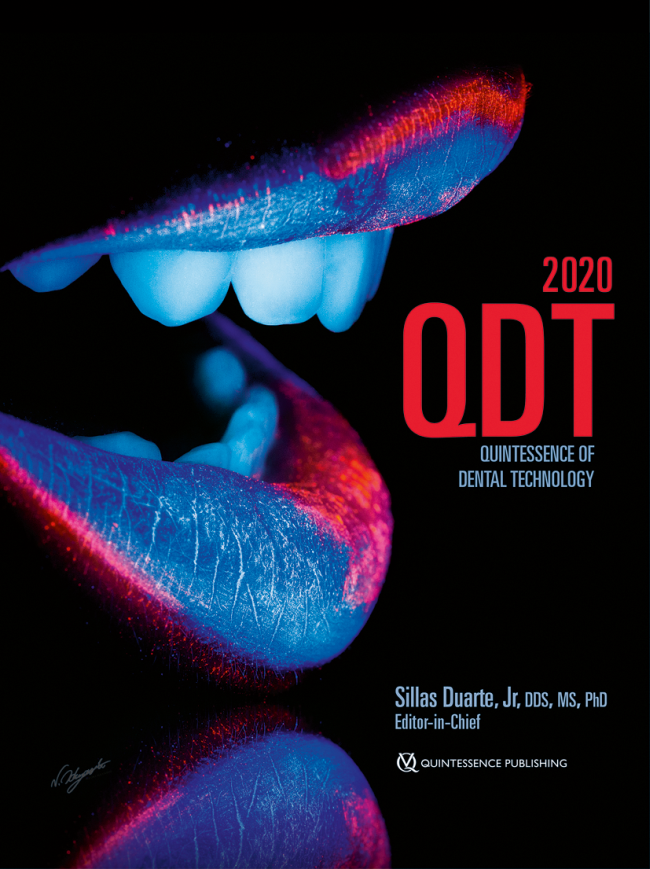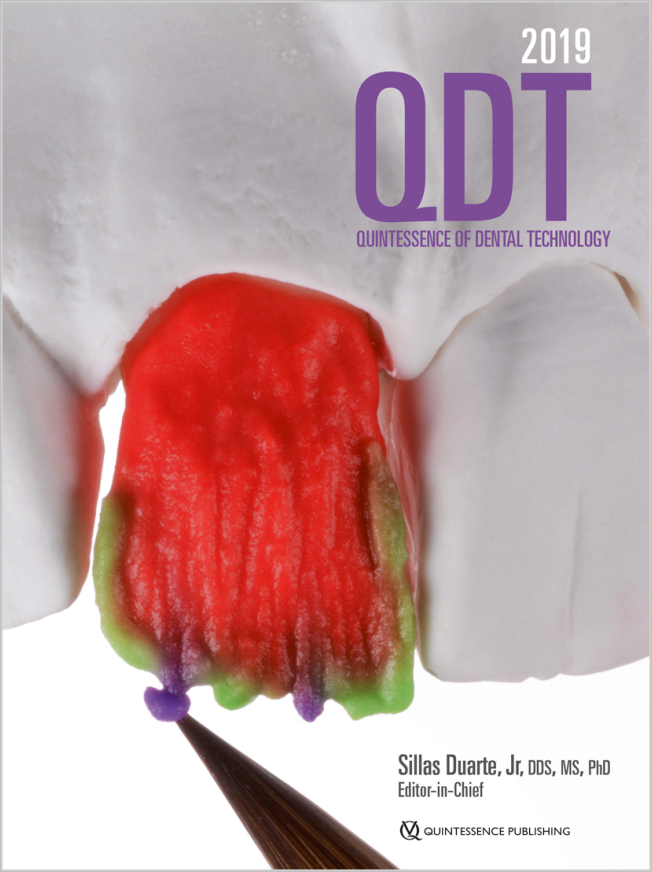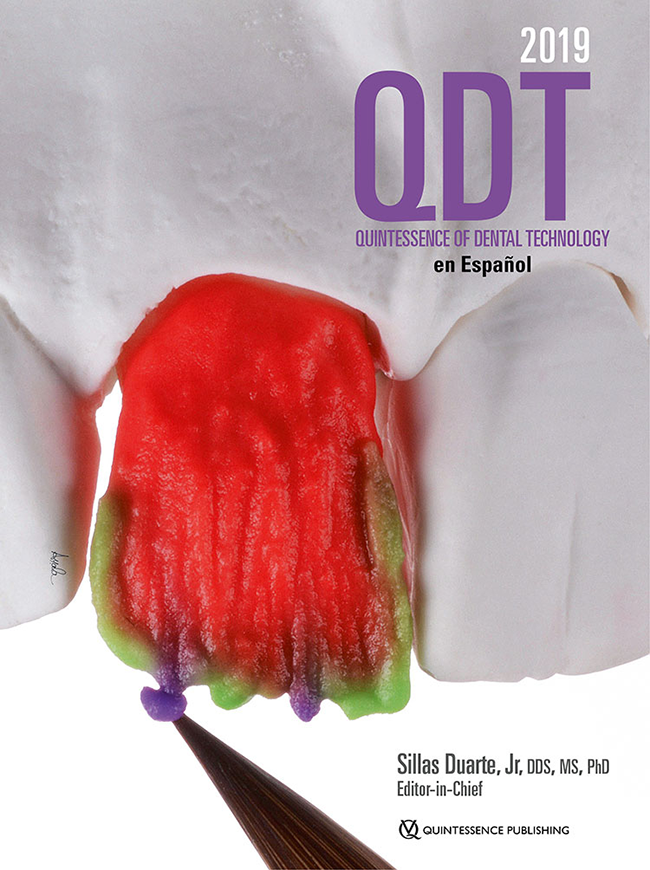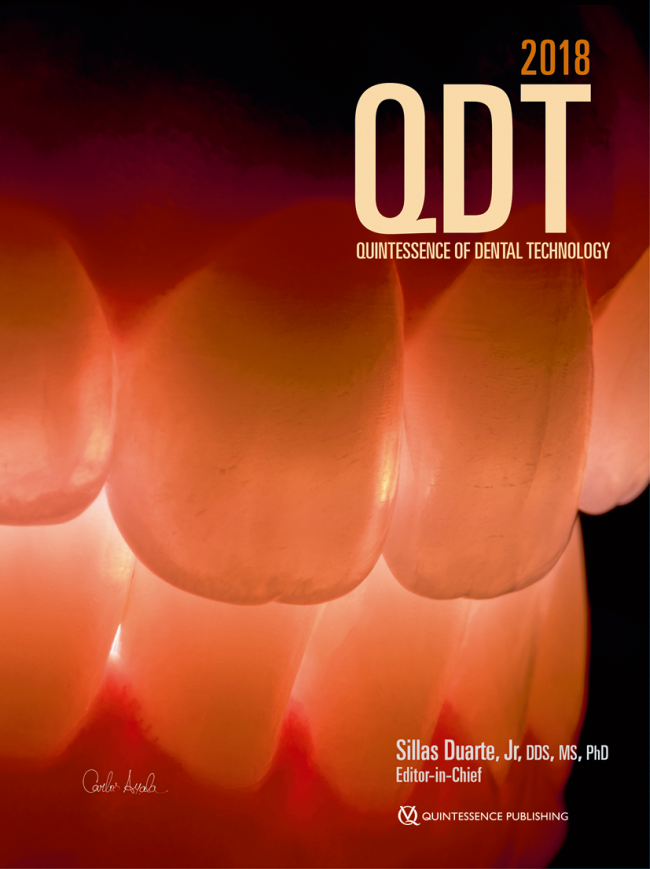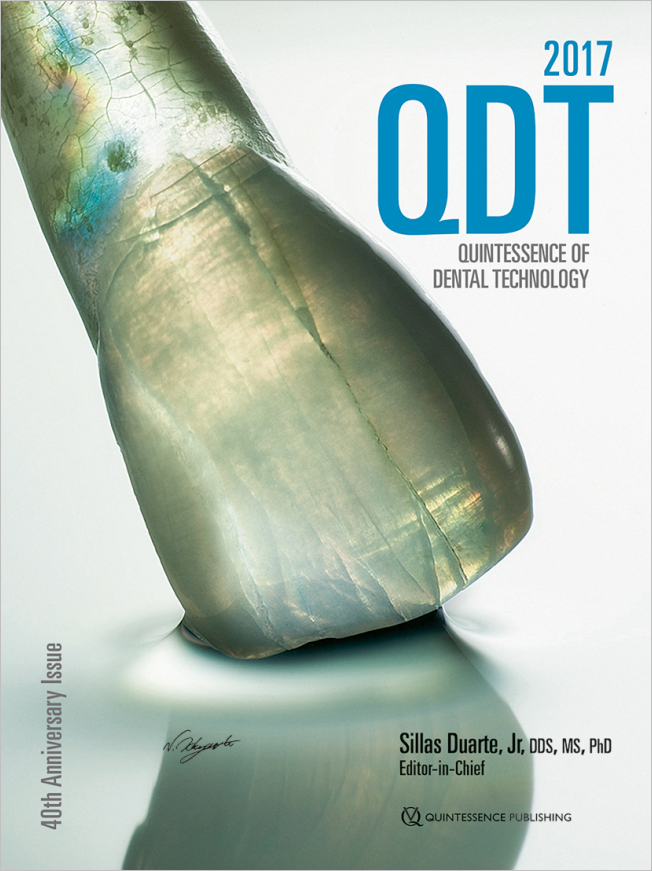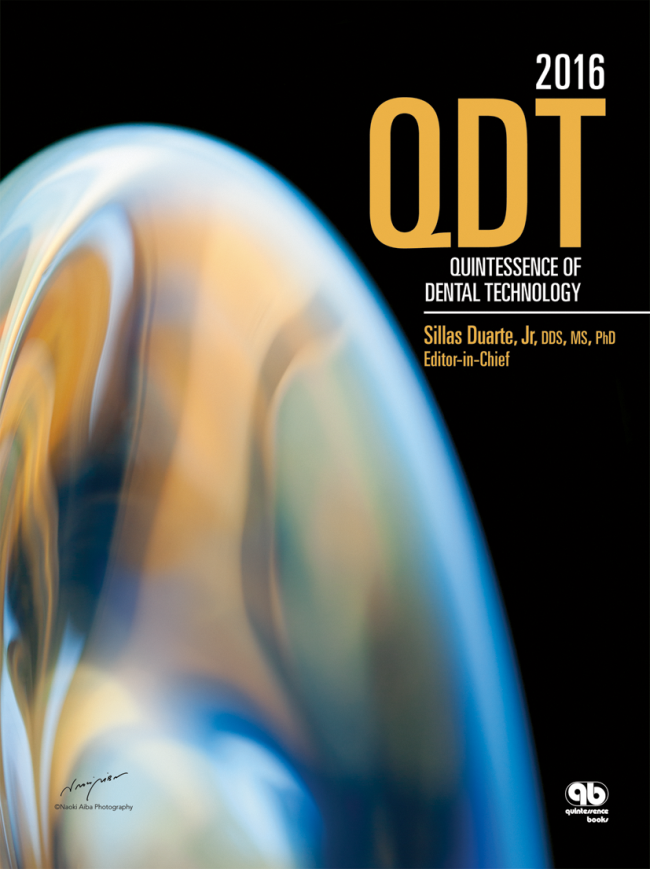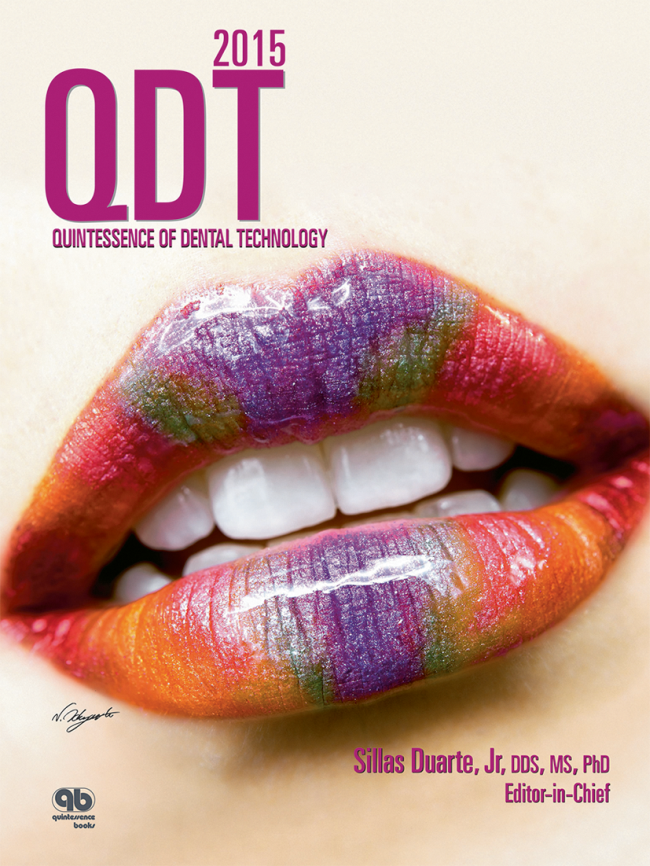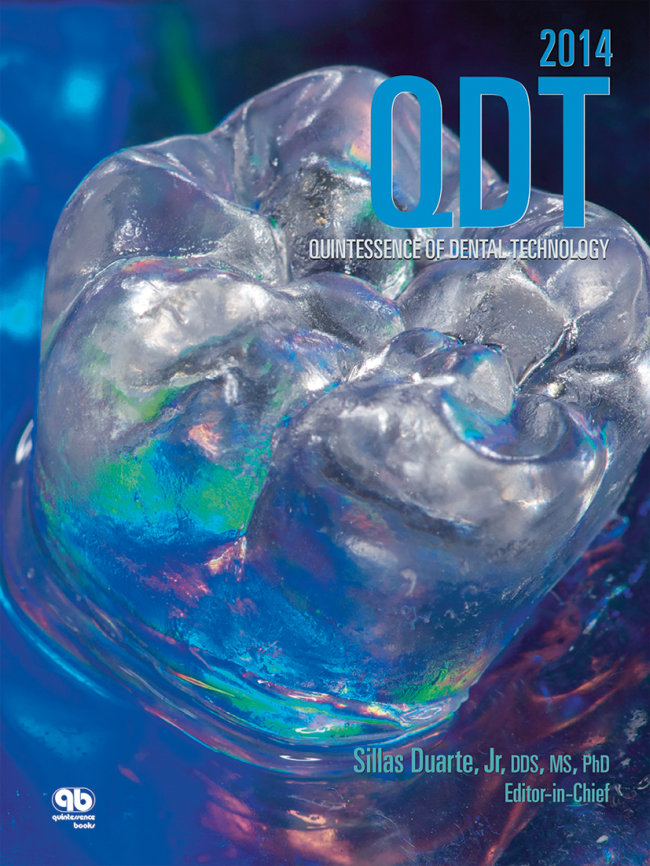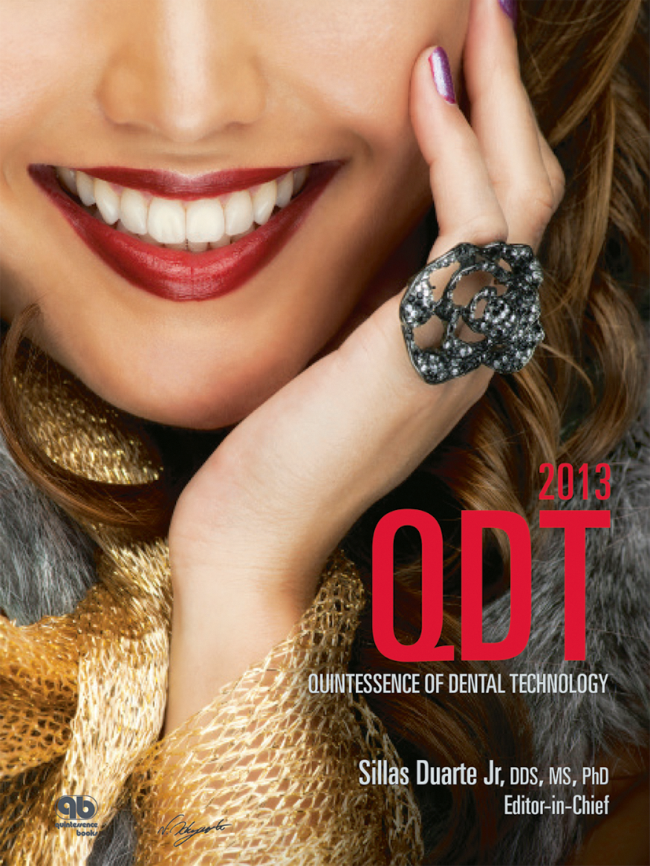QZ - Quintessenz Zahntechnik, 3/2022
ErfahrungsberichtPáginas 256-269, Idioma: AlemánKano, Paolo / Thiemi Saito Campos, Priscila / Lacerda da Silva, Emerson / da Silva Ferro, Rafael / Duarte Jr., SillasDie Cllones-LibraryDie Nachbildung natürlicher Zahnmorphologie gehört zu den wichtigsten Aufgaben von Zahnmedizinern und Zahntechnikern, bleibt aber immer ein Stück weit auch ihrem Geschick und ihrer Interpretation der Wirklichkeit überlassen. Der Beitrag beschreibt die Herstellung multipler Kopien mithilfe digitaler Technik. Dazu haben die Autorinnen und Autoren unter anderem eine digitale Zahnbibliothek entwickelt. Der Beitrag beschreibt die einzelnen Schritte des Vorgehens.
Palabras clave: CAD/CAM, Morphologie, Keramikveneer, digitale Bibliothek, Intraoralscan
Quintessence International, 4/2019
DOI: 10.3290/j.qi.a42098, ID de PubMed (PMID): 30887962Páginas 288-293, Idioma: InglésSánchez-Monescillo, Andrés / Hernanz-Martín, Jaime / González-Serrano, Carlos / González-Serrano, José / Duarte jr., SillasConventional implant impression techniques may introduce distortions in the framework that can lead to a lack of accuracy of the prostheses. Misfit between the restoration and the implants facilitates the occurrence of biomechanical failures and prostheses complications due to inadequate stress dissipation. Digital impressions present an alternative to eliminate procedural distortions by improving the fit between the restoration and the implants. Among the different types of digital impressions, photogrammetry has emerged as an alternative for multiple implant impressions. This case report describes photogrammetric technique for a full-arch rehabilitation in All-on-four of a 68-year-old patient with a fixed implant-supported restoration on the mandible. Photogrammetric technique has demonstrated to be a successful digital alternative to conventional multiple-implant impression. Esthetics and function remained stable over a follow-up period of 1 year. No biomechanical or biologic complications were observed.
Palabras clave: All-on-four, digital impression, implant impression, photogrammetric impression, photogrammetry, stereophotogrammetric impression
QZ - Quintessenz Zahntechnik, 10/2015
SciencePáginas 1290-1305, Idioma: AlemánDuarte jr., Sillas / Sartori, Neimar / Cascione, Domenico / Phark, Jin-HoKeramikverstärkte Polymere sind moderne Werkstoffe, die die Vorteile von Keramiken und Kompositen zu kombinieren versuchen. Die Materialien mit verschiedenen keramischen Füllstoffanteilen von über 80 % werden industriell polymerisiert und als CAD/CAM-Blöcke angeboten. Dieser Überblick untersucht für die beiden verfügbaren Produkte (Vita Enamic, Lava Ultimate) Materialeigenschaften wie Festigkeit, Verschleißverhalten, Adhäsion und ästhetische Merkmale und vergleicht sie mit einer CAD/CAM-Lithiumdisilikat-Glaskeramik. Eine Kasuistik demonstriert die gute Verwendbarkeit. Keramikverstärkte Polymere zeigen gute ästhetische und mechanische Eigenschaften und sind für Front- wie Seitenzahnrestaurationen geeignet.
Palabras clave: keramikverstärktes Polymer, polymerinfiltrierte Keramik, Resin-Nanokeramik, Lithiumdisilikat-Glaskeramik, CAD/CAM, Ästhetik, Adhäsion, Festigkeit, Verschleiß
QZ - Quintessenz Zahntechnik, 7/2012
SciencePáginas 806-817, Idioma: AlemánRey Duro, Fernando / Andrade, Joana Souza / Duarte jr., SillasDer Beitrag stellt eine Studie vor, in der eine In-vivo-Analyse der Fluoreszenz von natürlichen Zähnen sowie ein Vergleich von unterschiedlichsten Kompositkunststoffen im Hinblick auf ihre Fluoreszenzeigenschaften. Die Untersuchungen wurden unter Anwendung einer standardisierten fotografischen Aufnahmemethode ausgeführt.
Palabras clave: Kompositverblendungen, natürliche Zähne, Fluoreszenz, Fluoreszenzfotografie, Veneers
The International Journal of Oral & Maxillofacial Implants, 5/2012
ID de PubMed (PMID): 23057014Páginas 1023-1028, Idioma: InglésPires, Luis Fernando S. / Tandler, Bernard / Bissada, Nabil / Duarte jr., SillasPurpose: In current practice, two types of burs are typically used: stainless steel (SS) and alumina-toughened zirconia (ATZ). The present study evaluated the durability of these two burs in relation to osteotomy creation for implant placement. In addition, the effects of the two types of burs on a bone model were examined.
Materials and Methods: SS and ATZ burs were compared under controlled conditions in a swine rib osteotomy. The heat generated and time necessary for perforation were measured and analyzed with repeated-measures one-way analysis of variance. The burs and bone samples were evaluated using scanning electron microscopy.
Results: New ATZ and SS burs showed greater bone disruption compared to burs that had been used 80 times. Brand new burs of either material showed small manufacturing defects, which increased in number with use. No clinically or statistically significant differences were found between burs with respect to temperature and time for perforation.
Conclusions: SS and ATZ burs can be used several times for implant site preparation under controlled conditions without reaching a temperature that is harmful to the bone. Both burs wear under repeated use, but not to an excessive degree. The duller burs produced smoother perforations than did the new ones.
Palabras clave: burs, dental implants, heat, osteotomy, stainless steel, temperature, zirconia
Quintessence International, 5/2008
ID de PubMed (PMID): 19088956Páginas 413-419, Idioma: InglésDuarte jr., Sillas / Saad, José Roberto CuryObjective: Control of microleakage represents a challenge for posterior composite restorations. The technique for composite placement may reduce microleakage. The null hypothesis of this in vitro study was that centripetal incremental insertion of composite resin would result in less microleakage than that obtained with the oblique incremental technique or bulk technique.
Method and Materials: Standardized Class 2 preparations were made in 60 caries-free extracted third molars and randomly assigned to 3 groups (n = 20): (1) oblique incremental insertion technique (control), (2) centripetal incremental insertion technique, and (3) bulk insertion. The teeth were restored with a total-etch adhesive and microhybrid composite resin. The specimens were isolated with nail varnish except for a 2-mmwide area around the restoration and then thermocycled (1,000 thermal cycles, 5°C/55°C; 30-second dwell time). The specimens were immersed in an aqueous solution of 50% silver nitrate for 24 hours, followed by 8 hours of immersion in a photo-developing solution and subsequently evaluated for leakage. The microleakage scores (0 to 4) obtained from the occlusal and cervical walls were analyzed with median nonparametric tests (P .05).
Results: The null hypothesis was rejected. All techniques attained statistically similar dentin microleakage scores (P = .15). The centripetal insertion technique displayed significantly less microleakage than the oblique technique at the enamel margins (P = .04).
Conclusion: None of the techniques eliminated marginal microleakage in Class 2 preparations. However, in occlusal areas, the centripetal technique performed significantly better than the other techniques.
Palabras clave: bulk, centripetal placement, Class 2 composite resin, dentin, enamel, marginal adaptation, oblique placement
International Journal of Esthetic Dentistry (EN), 3/2008
ID de PubMed (PMID): 19655540Páginas 224-234, Idioma: InglésDuarte jr., Sillas / Schnider, Patrick / Lorezon, Ana PaulaThe aim of this study was to investigate the importance of the width/length (W/L) ratio of maxillary anterior permanent teeth in anterior esthetic rehabilitation. Digital photographs were taken of the anterior teeth for each participant (approximately 20 years old). A maxillary impression was taken with irreversible hydrocolloid and cast in die stone under vacuum. The widest mesiodistal width and incisogingival length of the tested teeth were measured. The data were submitted to analysis of variance, which showed significant statistical differences within each parameter (P .05). The width and length measurements varied between maxillary anterior teeth in the following order: central incisors > canines > lateral incisors. Maxillary central incisors displayed the largest W/L ratio (85%), maxillary lateral incisors (LI) displayed the smallest W/L ratio (79%), and canines displayed the intermediate W/L ratio (83%). These dimensions have a positive effect on the final restoration; therefore, it is suggested that the specific width, length, and W/L ratio should be used in esthetic rehabilitations of maxillary anterior teeth.
International Journal of Esthetic Dentistry (DE), 3/2008
Páginas 246-257, Idioma: AlemánDuarte jr., Sillas / Schnider, Patrick / Lorezon, Ana PaulaIn dieser Studie wurde die Bedeutung des Breiten-/Längenverhältnisses (B/L) der bleibenden oberen Frontzähne für die ästhetische Rehabilitation untersucht. Von jedem Probanden (etwa 20 Jahre alt) wurden Digitalaufnahmen der Frontzähne angefertigt. Mit irreversiblem Hydrokolloid wurde der Oberkiefer abgeformt. Mit einem Hartgips wurden Modelle hergestellt. Die größte mesiodistale Breite und inzisogingivale Länge der untersuchten Zähne wurden gemessen. Die Daten wurden mit einer Varianzanalyse untersucht, die für jeden Parameter signifikante statistische Unterschiede zeigte (P 0,05). Die gemessenen Breiten und Längen variierten zwischen den oberen Frontzähnen in der folgenden Reihenfolge: zentrale Schneidezähne > Eckzähne > laterale Schneidezähne. Die oberen zentralen Schneidezähne zeigten das größte Breiten-Längenverhältnis (85 %), die oberen lateralen Schneidezähne das kleinste Breiten-Längenverhältnis (79 %) und die Eckzähne lagen dazwischen (83 %). Diese Dimensionen wirken sich positiv auf die definitive Restauration aus. Deshalb wird vorgeschlagen, dass bei ästhetischen Rehabilitationen der oberen Frontzähne die spezifische Breite und Länge und das entsprechende Breiten-Längenverhältnis gewählt werden sollten.
Quintessence International, 10/2007
ID de PubMed (PMID): 18197322Páginas 829-835, Idioma: InglésDuarte jr., Sillas / Dinelli, Welingtom / Carmona da Silva, Maria HelenaObjective: To evaluate the marginal microleakage in enamel and dentin/cementum walls in preparations with a high C-factor, using 3 resin composite insertion techniques. The null hypothesis was that there is no difference among the 3 resin composite insertion techniques.
Method and Materials: Standardized Class 5 cavities were prepared in the lingual and buccal aspects of 30 caries-free, extracted third molars. The prepared teeth were randomly assigned to 3 groups: (1) oblique incremental placement technique, (2) horizontal incremental placement technique, and (3) bulk insertion (single increment). The preparations were restored with a 1-bottle adhesive (Single Bond, 3M ESPE) and microhybrid resin composite (Z100, 3M ESPE). Specimens were isolated with nail varnish except for a 2-mm-wide rim around the restoration and thermocycled (1,000 thermal cycles, 5°C/55°C; 30-second dwell time). The specimens were immersed in an aqueous solution of 50 wt% silver nitrate for 24 hours, followed by 8 hours in a photo-developing solution and evaluated for microleakage using an ordinal scale of 0 to 4. The microleakage scores obtained from occlusal and gingival walls were analyzed with Wilcoxon and Kruskal-Wallis nonparametric tests.
Results: The null hypothesis was accepted. The horizontal incremental placement technique, the oblique incremental technique, and bulk insertion resulted in statistically similar enamel and dentin microleakage scores.
Conclusion: Neither the incremental techniques nor the bulk placement technique were capable of eliminating the marginal microleakage in preparations with a high C-factor.
Palabras clave: adhesion, adhesive, C-factor, dentin, enamel, resin composite
The Journal of Adhesive Dentistry, 1/2005
DOI: 10.3290/j.jad.a10085Páginas 51-56, Idioma: InglésDuarte jr., Sillas / Lolato, Antonio Luiz / de Freitas, Cláudia Regina Buainain / Dinelli, WelingtomPurpose: This study tested the null hypothesis that different treatments of saliva-contaminated substrate would not affect microgap formation at the dentin walls of bonded restorations.
Materials and Methods: Forty freshly extracted human molars received standardized Class V preparations on buccal and lingual surfaces. The specimens were assigned to four experimental groups (n = 20): [G1] no contamination (control group), [G2] saliva contamination (10 s) after etching followed by 5 s air stream; [G3] saliva contamination after etching and rinsed for 10 s; and [G4] re-etching for 10 s after saliva contamination. All specimens were restored with a one-bottle adhesive (Single Bond, 3M ESPE) and microhybrid composite resin (Filtek Z250, 3M ESPE) according to the manufacturer's instructions. The specimens were thermocycled, sectioned through the center of the restoration, and then processed for SEM. Microgaps were measured at the axial wall at 1500X magnification. The data were submitted to Kruskal-Wallis nonparametric statistical analysis at p 0.05.
Results: The data revealed that different groups resulted in a statistically significant difference (p 0.01) in gap formation. Air drying [G2] and rinsing [G3] the saliva-contaminated dentin resulted in similar microgap values (p > 0.05). However, re-etching the dentin after saliva contamination [G4] increased microgap formation (p 0.05) when compared with the groups G1 and G2. Although air drying and rinsing produced results comparable to noncontaminated dentin, the presence of microgaps was not completely eliminated.
Conclusion: Contaminated saliva did not prevent hybrid layer formation; however, it did reduce the adaptation of the restorative material to bonded surfaces.
Palabras clave: saliva, contamination, adhesive microgap





